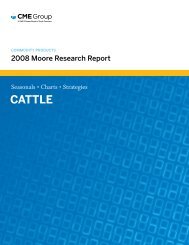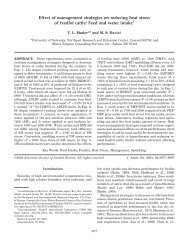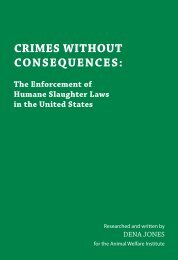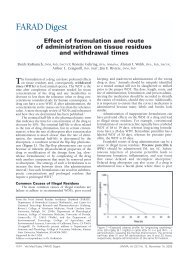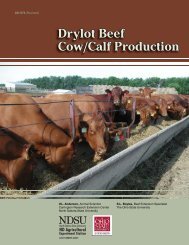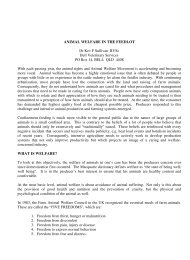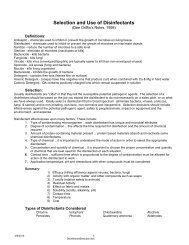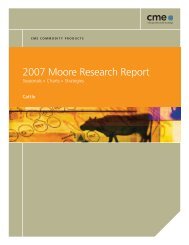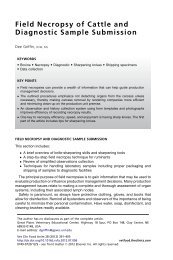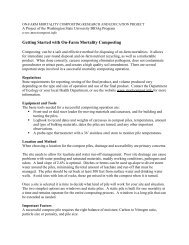Disposal of Livestock Mortality in Nebraska - infoHouse
Disposal of Livestock Mortality in Nebraska - infoHouse
Disposal of Livestock Mortality in Nebraska - infoHouse
You also want an ePaper? Increase the reach of your titles
YUMPU automatically turns print PDFs into web optimized ePapers that Google loves.
UNL's <strong>Livestock</strong><br />
Environ menta l<br />
Issues Committee<br />
Includes<br />
representation from<br />
UNL, <strong>Nebraska</strong><br />
Depa rtment o f<br />
Environ menta l<br />
Quality , Natura l<br />
Resources<br />
Conser vation S ervice,<br />
Natural Resources<br />
Districts, Center for<br />
Rural A ffairs,<br />
Nebra ska Ca ttlemen ,<br />
USDA Ag Research<br />
Services, and<br />
<strong>Nebraska</strong> Pork<br />
Producers<br />
Association.<br />
Contact:<br />
Chris Henry<br />
217 L W Ch ase Hall<br />
University <strong>of</strong> NE<br />
L<strong>in</strong>coln, NE 68583<br />
(402) 472-6529<br />
chenry@.unl.edu<br />
Volume 6, Number 2<br />
<strong>Disposal</strong> <strong>of</strong> <strong>Livestock</strong> <strong>Mortality</strong> <strong>in</strong> <strong>Nebraska</strong><br />
Chris Henry, Bob Wills, and Jeff Wild<br />
Extension Eng<strong>in</strong>eer, UNL; Extension Sw<strong>in</strong>e Veter<strong>in</strong>arian, UNL; Program Specialist, NDA<br />
Overview <strong>of</strong> <strong>Disposal</strong> Options<br />
Changes were made recently <strong>in</strong> the <strong>Nebraska</strong> statutes govern<strong>in</strong>g the disposal <strong>of</strong> dead<br />
animals. Injection <strong>of</strong> liquefied animal rema<strong>in</strong>s is no longer an approved method <strong>of</strong><br />
carcass disposal. The methods now approved for the disposal <strong>of</strong> dead pigs <strong>in</strong>clude<br />
burial <strong>of</strong> the carcass at least four feet below the surface <strong>of</strong> the ground, complete<br />
burn<strong>in</strong>g <strong>of</strong> the carcass <strong>in</strong> a permitted <strong>in</strong>c<strong>in</strong>erator, removal by a licensed render<strong>in</strong>g<br />
company, and compost<strong>in</strong>g. Burial, burn<strong>in</strong>g, <strong>in</strong>c<strong>in</strong>eration, and compost<strong>in</strong>g must be<br />
done on the premises where the animals have died. Compost<strong>in</strong>g is limited to<br />
carcasses up to 300 pounds. In all <strong>in</strong>stances, carcasses must be disposed <strong>of</strong> with<strong>in</strong><br />
36 hours <strong>of</strong> death and must be disposed <strong>of</strong> on the premise that the animal died.<br />
Render<strong>in</strong>g:<br />
Render<strong>in</strong>g companies recycle animal carcasses <strong>in</strong>to useful byproducts. Fatty acids,<br />
bone meal, and soaps are some <strong>of</strong> the products generated. Meat pack<strong>in</strong>g plants have<br />
become more efficient <strong>in</strong> their abilities to recover and process byproducts and have<br />
become more competitive with render<strong>in</strong>g companies. As a result <strong>of</strong> this<br />
competition, some areas have been left without render<strong>in</strong>g pickup service. F<strong>in</strong>ally,<br />
consider the higher biosecurity risk s<strong>in</strong>ce render<strong>in</strong>g trucks can carry organisms from<br />
farm to farm.<br />
Inc<strong>in</strong>eration and Open Burn<strong>in</strong>g<br />
An <strong>in</strong>c<strong>in</strong>erator is essentially a convection oven (starved air combustor) that burns a<br />
carcass under a controlled environment at a very high temperature, reduc<strong>in</strong>g the<br />
carcass to ashes. These devices are typically diesel fueled and require anywhere<br />
from 1 to 3 gallons <strong>of</strong> fuel per 100 lb <strong>of</strong> carcass.<br />
To own and operate an <strong>in</strong>c<strong>in</strong>erator <strong>in</strong> the state <strong>of</strong> <strong>Nebraska</strong> requires a Class 2 NDEQ<br />
operat<strong>in</strong>g and construction permit. The owner is also required to report the weight<br />
<strong>of</strong> carcasses burned annually to the NDEQ. There may be county and city
UNL's <strong>Livestock</strong><br />
Environ menta l<br />
Issues Committee<br />
Includes<br />
representation from<br />
UNL, <strong>Nebraska</strong><br />
Depa rtment o f<br />
Environ menta l<br />
Quality , Natura l<br />
Resources<br />
Conser vation S ervice,<br />
Natural Resources<br />
Districts, Center for<br />
Rural A ffairs,<br />
Nebra ska Ca ttlemen ,<br />
USDA Ag Research<br />
Services, and<br />
<strong>Nebraska</strong> Pork<br />
Producers<br />
Association.<br />
Contact:<br />
Chris Henry<br />
217 L W Ch ase Hall<br />
University <strong>of</strong> NE<br />
L<strong>in</strong>coln, NE 68583<br />
(402) 472-6529<br />
chenry@.unl.edu<br />
ord<strong>in</strong>ances <strong>in</strong> place concern<strong>in</strong>g <strong>in</strong>c<strong>in</strong>erators and it is the producers responsibility to<br />
comply with these local laws. Aside from the legal requirements, <strong>in</strong>c<strong>in</strong>erat<strong>in</strong>g can<br />
become a nuisance to neighbors. The smoke generated from <strong>in</strong>c<strong>in</strong>erat<strong>in</strong>g can<br />
generate compla<strong>in</strong>ts from neighbors. F<strong>in</strong>ally, burn<strong>in</strong>g carcasses <strong>in</strong> open pits does<br />
not comply with NDEQ air quality standards.<br />
Burial<br />
The carcasses must be buried at least 4 feet below the surface <strong>of</strong> the ground with<strong>in</strong><br />
36 hours. However, there are many challenges and risks associated with this<br />
disposal method. First, earth-mov<strong>in</strong>g equipment must be used to excavate a hole or<br />
trench for the carcasses, and dur<strong>in</strong>g w<strong>in</strong>ter months it is difficult if not impossible to<br />
bury the carcasses <strong>in</strong> frozen soil. F<strong>in</strong>ally, the liquid from decompos<strong>in</strong>g carcasses<br />
can pose a risk to groundwater. Consider this option for catastrophic losses. The<br />
penalty for improper burial is considered a Class II misdemeanor.<br />
Compost<strong>in</strong>g:<br />
Compost<strong>in</strong>g is the action <strong>of</strong> thermophilic, aerobic bacteria convert<strong>in</strong>g carcasses to<br />
organic residue, humic acids, and bacterial biomass. The process generates heat,<br />
carbon dioxide, and water. This method was just approved <strong>in</strong> the last legislative<br />
session and the compost<strong>in</strong>g regulations for <strong>Nebraska</strong> should be written by January 1,<br />
2000. Currently legislative statutes limit compost<strong>in</strong>g to carcasses less than 300<br />
pounds. The basic concept can be described as bury<strong>in</strong>g the animal above ground <strong>in</strong><br />
a bio-filter. Typically, the animal is placed on a bed <strong>of</strong> sawdust (or other carbon<br />
source) and covered and left to decay. The process <strong>of</strong> compost<strong>in</strong>g <strong>in</strong>volves the<br />
decomposition <strong>of</strong> organic material by microorganisms under controlled conditions.<br />
The tissues <strong>of</strong> carcasses are broken down aerobically by bacteria, fungi,<br />
act<strong>in</strong>omycetes, and protozoa. High temperatures are <strong>in</strong>dicative <strong>of</strong> good microbial<br />
activity and will reach 120 to 160 degrees Fahrenheit. An <strong>in</strong>ternal pile temperature<br />
<strong>of</strong> 131 degrees for 3 days should be sufficient to destroy pathogens.<br />
Compost<strong>in</strong>g can be accomplished fairly easily and economically. Additional time<br />
and equipment are needed compared to the other methods <strong>of</strong> carcass disposal. First,<br />
a site must be selected that is considerable distance from surface water and<br />
groundwater sources. It is also beneficial to locate the facility away from neighbors<br />
and human dwell<strong>in</strong>gs. Consider the dra<strong>in</strong>age <strong>of</strong> the site when decid<strong>in</strong>g what type <strong>of</strong><br />
compost facility to build. There should be no extraneous surface water contact<strong>in</strong>g<br />
the compost area. Consider build<strong>in</strong>g clean water diversions to handle clean run<strong>of</strong>f<br />
water.<br />
Equipment and labor are needed to successfully operate a compost facility. A<br />
bucket loader or skid steer is needed to transport carcasses from build<strong>in</strong>gs or lots to<br />
the compost facility. Time will be needed to cover the carcasses and move piles<br />
from the primary to the secondary stages. Haul<strong>in</strong>g and load<strong>in</strong>g <strong>of</strong> <strong>in</strong>com<strong>in</strong>g carbon<br />
source and removal <strong>of</strong> f<strong>in</strong>ished compost is also needed to operate the compost piles.<br />
Contact the State Veter<strong>in</strong>arians Office for regulatory <strong>in</strong>formation concern<strong>in</strong>g disposal <strong>of</strong> livestock<br />
mortalities (402-4 71-2351).<br />
Issued <strong>in</strong> furtherance <strong>of</strong> Cooperative Extension work, Acts <strong>of</strong> May 8 and June 30, 1914, <strong>in</strong> cooperative with the U.S. Department <strong>of</strong><br />
Agricu lture. Ken neth R. B olen, Dire ctor <strong>of</strong> Co operative Extens ion, Un iversity <strong>of</strong> N ebraska , Institute <strong>of</strong> A griculture and N atural Re sources.<br />
University <strong>of</strong> <strong>Nebraska</strong> Cooperative Extension educational programs abide with the non-discrim<strong>in</strong>ation policies <strong>of</strong> the University <strong>of</strong> <strong>Nebraska</strong><br />
L<strong>in</strong>coln and the United S tates Dep artmen t <strong>of</strong> Agricu lture.




